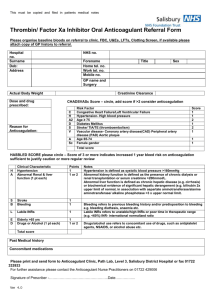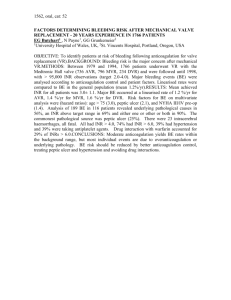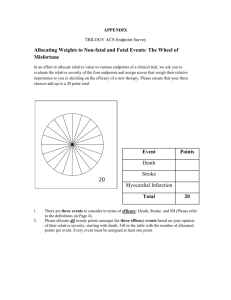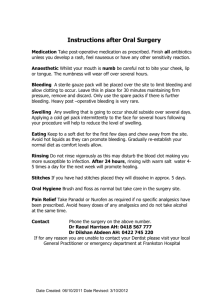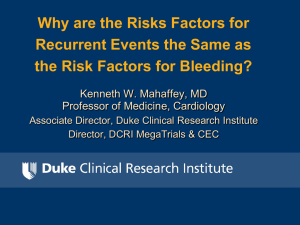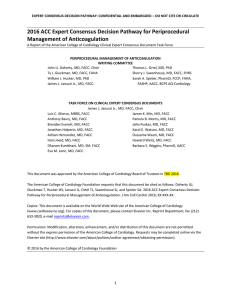Assessment of the risk of bleeding during anticoagulation therapy
advertisement
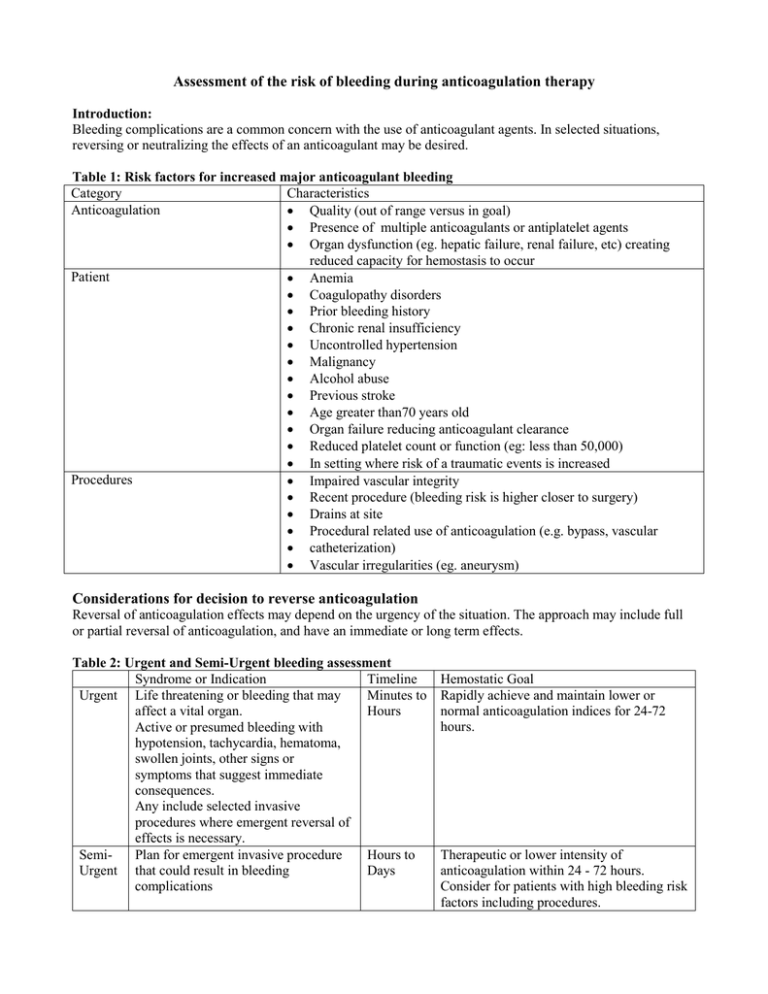
Assessment of the risk of bleeding during anticoagulation therapy Introduction: Bleeding complications are a common concern with the use of anticoagulant agents. In selected situations, reversing or neutralizing the effects of an anticoagulant may be desired. Table 1: Risk factors for increased major anticoagulant bleeding Category Characteristics Anticoagulation • Quality (out of range versus in goal) • Presence of multiple anticoagulants or antiplatelet agents • Organ dysfunction (eg. hepatic failure, renal failure, etc) creating reduced capacity for hemostasis to occur Patient • Anemia • Coagulopathy disorders • Prior bleeding history • Chronic renal insufficiency • Uncontrolled hypertension • Malignancy • Alcohol abuse • Previous stroke • Age greater than70 years old • Organ failure reducing anticoagulant clearance • Reduced platelet count or function (eg: less than 50,000) • In setting where risk of a traumatic events is increased Procedures • Impaired vascular integrity • Recent procedure (bleeding risk is higher closer to surgery) • Drains at site • Procedural related use of anticoagulation (e.g. bypass, vascular • catheterization) • Vascular irregularities (eg. aneurysm) Considerations for decision to reverse anticoagulation Reversal of anticoagulation effects may depend on the urgency of the situation. The approach may include full or partial reversal of anticoagulation, and have an immediate or long term effects. Table 2: Urgent and Semi-Urgent bleeding assessment Syndrome or Indication Timeline Urgent Life threatening or bleeding that may Minutes to affect a vital organ. Hours Active or presumed bleeding with hypotension, tachycardia, hematoma, swollen joints, other signs or symptoms that suggest immediate consequences. Any include selected invasive procedures where emergent reversal of effects is necessary. SemiPlan for emergent invasive procedure Hours to Urgent that could result in bleeding Days complications Hemostatic Goal Rapidly achieve and maintain lower or normal anticoagulation indices for 24-72 hours. Therapeutic or lower intensity of anticoagulation within 24 - 72 hours. Consider for patients with high bleeding risk factors including procedures. Appendix: Risk assessment scores: Several risk assessment tools have been explored, and may be used in various settings such as acute coronary syndromes. For assessing the risk of bleeding with long term anticoagulation, the HASBLED score has been proposed as simple bleeding risk assessment tool to guide management decisions. HAS-BLED scoring system: [For atrial fibrillation patients] Hypertension: 1 point for uncontrolled high blood pressure - systolic (greater or equal to 160mmHg) Abnormal kidney and/or liver function: - 1 point for impaired kidney or liver function - 2 points for both Stroke: 1 point for previous history of stroke, especially deep brain (lacunar) stroke Bleeding: 1 point for previous history of bleeding, anemia or having predisposition to bleeding Labile INR: 1 point for unstable or high INRs, or poor time (less than 60%) in the therapeutic time range. - Not necessarily easy to validate in acutely ill inpatients Elderly: 1 point for age greater than or equal to 65 years Drugs and/or alcohol: - 1 point for taking antiplatelet drugs (e.g. aspirin, clopidogrel, prasugrel, ticagrelor, etc…) - 1 point for consuming 8 or more alcoholic drinks per week - 2 points for both HAS-BLED Score Major Bleeding Risk* per 100 patient years 0 0.9% 1 3.4% 2 4.1% 3 5.8% 4 8.9% 5 9.1% 6 Number of subjects too small to estimate *Overall percent of Major Bleeds during oral vitamin K antagonist therapy to prevent stroke in patients with AF observed in two trials (mean duration of therapy 17 and 24 months/trial). Ref: Lip GH et al. JACC 2011;57:173-80 Approved by UCDHS P&T Committee 8/2014.
